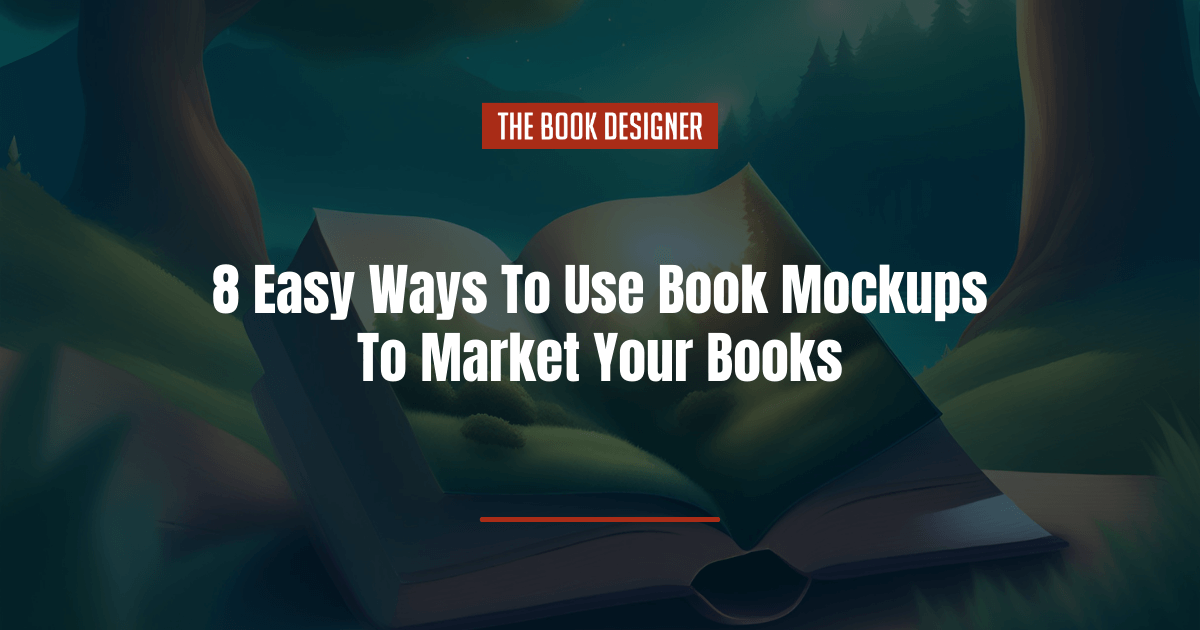Contrary to the popular axiom, many in the book community do judge books by their covers. Book covers are the first, and often most lasting impression of a book.
Beyond simply conveying the title and author, a well-designed book cover captures the essence of the story, establishes the book’s genre, and entices potential readers. This makes it a powerful tool for branding and marketing, influencing readers’ perceptions and sparking interest on bookstore shelves and/or online platforms.
However, authors and designers alike have taken book covers a step further. Instead of using a simple image of a book cover, they now use book mockups — a realistic representation of how a cover design will appear in various formats, including paperback, hardcover, and digital versions.
In this article, we’ll explore what book mockups are and some practical ways you can use book mockups to market your books.
Learn about book mockups:
What Are Book Mockups?
A book mockup is a visual representation of your book’s cover and spine design, presented in a realistic manner. It’s used to give your target audience an idea of what the final printed or digital book will look like in a three-dimensional context.

Book mockups give you (an author, publisher, or designer) the opportunity to assess the design’s aesthetics and make any necessary adjustments. They also allow you to showcase and promote your book cover before the actual printing or publication. They invoke excitement among potential readers, reminding them to keep an eye out for your publication date so they can buy your book.
8 Ways to Market Your Book with Book Mockups
If you’re exploring how to market your book with book mockups, here are a few strategies you can try:
1. Social Media Teasers
With billions of users worldwide, social media platforms are a great channel to promote your book. However, it can be hard to stand out among all the other content posted by authors who are also trying to market their books.
Book mockups can help you grab (and keep) the attention of potential readers, building anticipation and generating interest in your book. To use them effectively, share high-quality and visually appealing mockups of your book cover and spine on Instagram, Facebook, and X (formerly Twitter). Include captivating captions, quotes, or snippets from the book to give more context and encourage audience engagement.
2. Website and Blog Graphics
If you own a website or blog, you can incorporate your book mockups into the homepage, banners, sidebars, or dedicated sections — preferably with a short summary of what the book is about. This will draw your site visitors’ attention and entice them to explore further.
For example, Tomi Adeyemi, author of Children of Blood and Bone and Children of Virtue and Vengeance is set to release the last book in the trilogy in 2024. On her website, Adeyemi includes the book mockup of Book 3 titled Children of Anguish and Anarchy with a short description of the plot and some links where readers can purchase it when the book is released.

3. Email Campaigns
If you have an email list filled with people who’d like to read your work, you can incorporate your book mockup into your email newsletters and promotional emails. The visual appeal of the mockup will capture the attention of subscribers, giving them a sneak peek of the book cover and encouraging them to click for more information or to make a purchase.
4. Online Advertisements
If you’re running online ads on social media platforms or search engines, using book mockups as part of your ad visuals can increase click-through rates and improve ad performance.
This is because, instead of using a curated image telling people about your book, you’re using the actual image of the book’s cover and spine, which allows people to visualize what the book’s physical copy would look like and how it’d fit in with their book stash.
Pro tip: Ensure that the ad copy complements the visual elements of your mockup to convey a compelling message.
5. Book Launch Announcements
During your book launch, you can use your book mockup to create stunning visuals for your announcement on your website, social media profiles, and other relevant platforms. Use the book mockup as the central visual element, accompanied by details about the launch event, promotions, or other special offers.
Sharing the news with an attractive representation of your book cover helps build excitement and encourages potential readers to attend the launch and buy your book.
6. Author Interviews and Features
When participating in interviews or features you can provide journalists, bloggers, and influencers with high-quality mockups of your book to accompany videos, posts, or articles. This ensures a cohesive and recognizable visual representation of your book across various media outlets.
7. Book Signing Promotions
If you’re planning a book signing or event, incorporate your book mockups into promotional materials, such as posters, flyers, and online event pages. This reinforces the book’s presence, helps potential attendees recognize the book easily, and encourages them to participate in the event.
8. Reader Engagement
To encourage engagement and foster a sense of community among readers, you can initiate contests, challenges, and discussions related to your book on social media.
Encourage readers to share their interpretations or creative content inspired by the book cover (using the mockup). This includes fan art, book-related photos, or personal reflections.
Pro tip: Create unique hashtags to organize and track user-generated content, so you can use them in your book marketing strategy.
Generate Buzz for Your Books through Book Mockups
Book mockups are powerful marketing tools that enable you to create eye-catching promotional materials for social media, websites, and advertising — all of which contribute to your book’s marketability and success in a visually-driven industry.
By implementing these strategies, you can maximize the impact of book mockups in your marketing efforts, creating a strong and memorable presence for your books in the competitive publishing landscape.




